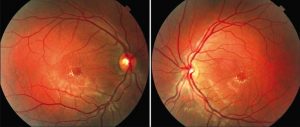Only 25% of diabetic patients undergo an annual examination. A joint effort of diabetologists and ophthalmologists is needed for increased early diagnosis
In Italy today, diabetic retinopathy (DR) affects over one million of people; a growing trend due both to the late diagnosis of type 2 diabetes (when complications, including retinopathy, are already manifest) and to the organisational difficulties of carrying out specific screening for this  problem. The eye fundus examination should be performed at the time of diagnosis in T2 diabetes and once every two years in the event of a negative result; in T1 diabetes five years after diagnosis and once a year thereafter. Despite the guidelines, according to the Association of Diabetes Physicians (AMD) only 25% of diabetic subjects undergoes annual screening for retinopathy. Increasing this percentage could contribute to the retinography, examination which, compared to the fundus oculi, has certain advantages: it can be performed by a trained operator (not necessarily a doctor) and does not require dilation of the pupil.
problem. The eye fundus examination should be performed at the time of diagnosis in T2 diabetes and once every two years in the event of a negative result; in T1 diabetes five years after diagnosis and once a year thereafter. Despite the guidelines, according to the Association of Diabetes Physicians (AMD) only 25% of diabetic subjects undergoes annual screening for retinopathy. Increasing this percentage could contribute to the retinography, examination which, compared to the fundus oculi, has certain advantages: it can be performed by a trained operator (not necessarily a doctor) and does not require dilation of the pupil.
Precisely in order to take stock of how to improve the control of DR, especially by promoting its early diagnosis, diabetologists and ophthalmologists met in Rome on 27 and 28 October 2018 at the AMD-sponsored conference: "Diabetic microangiopathy: focus on diabetic retinopathy".
"Diabetic retinopathy is the most important ocular complication of diabetes mellitus and at least one third of diabetics have more or less severe DR.", points out Franco Tuccinardi, scientific head of the event, Director UOC Diabetologia Ospedale di Formia. "Epidemiological studies tell us that retinal complications are the most common cause of blindness in adults of working age. Prevention of this problem, therefore, is crucial and can be pursued through good blood glucose control, but above all through screening: in countries that have implemented it systematically, in fact, blindness due to RD has been drastically reduced. A very useful tool, in this sense, is the retinograph which, by exploiting the digital recording of the image obtained without mydriasis (dilation of the pupil), allows its remote transmission and reporting. During this conference, which is part of the 'Sharing Events' project, events in which the AMD collaborates with professionals from other therapeutic areas, a theoretical and practical course is planned to explain the use of this instrument to diabetologists".
"International evidence and studies conducted in Italy have demonstrated the full effectiveness of secondary prevention programmes through the telemedicineby equipping basic facilities with a retinograph and using deferred remote reporting by the ophthalmologist'., explains Domenico Mannino, AMD President. "In this way, in addition to significant cost containment, it can be ensured that almost the entire diabetic population is reached and monitored, certainly doubling, if not tripling, the current numbers of patients being screened for DR'.
"Failure to screen for diabetic retinopathy and its inadequate management, in the absence of an adequate organisational response, will lead to an increase in the number of cases of reduced visual capacity to the point of loss of sight.", illustrates Riccardo Candido, AMD National Councillor and scientific head of the event. "Even before it reaches this extreme outcome, DR is already a very disabling issue, impacting on the patient's daily life, resulting in increasing direct costs, due to the management of the disease, and indirect costs, due to lost working days or early retirement. It is estimated that in period 2015-2030 this disease will generate a cost burden of EUR 4.2 billion".
Dr. Carmelo Chines
Direttore responsabile
